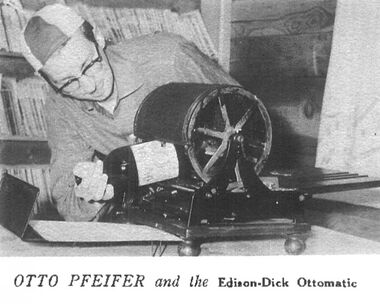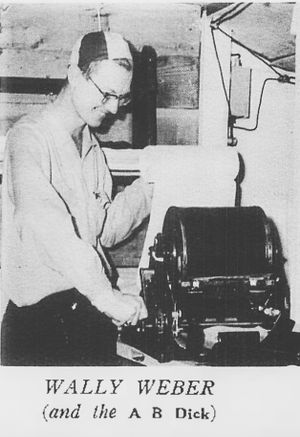Difference between revisions of "Mimeo"
| Line 37: | Line 37: | ||
** [https://youtu.be/eo06ZRXbgao University of Iowa video about Tarr’s mimeo.] | ** [https://youtu.be/eo06ZRXbgao University of Iowa video about Tarr’s mimeo.] | ||
*[https://youtu.be/rs5ahFHWaBc “Spirit Duplicators: Early 20th Century Copier Art, Fanzines and the Mimeograph Revolution.”] | *[https://youtu.be/rs5ahFHWaBc “Spirit Duplicators: Early 20th Century Copier Art, Fanzines and the Mimeograph Revolution.”] | ||
| + | * ''[[Building the AHMF $3.75 Mimeo]]''. | ||
See also: [[Twil-tone]], [[Vicolor]], [[Rexstripe]]. | See also: [[Twil-tone]], [[Vicolor]], [[Rexstripe]]. | ||
Revision as of 15:18, 6 October 2021

A mimeo, short for mimeograph, is a machine for printing with ink forced through a wax or plastic stencil cut with a typewriter, stylus or electrostenciller.
Used extensively for the production of fanzines throughout the early- to mid-20th century, mimeography was an art form that many fans gratefully gave up with the arrival of cheap photocopying and offset printing, beginning in the late '70s. Until that time, fanpublishing was as much of a handicraft as it was a literary exercise.
Well-known brands of mimeograph machines included A. B. Dick, Rex Rotary, Roneo, Speed-O-Print and the highly sought-after Gestetner.
The last holdouts for repro by mimeo included Rich and Nicki Lynch's Mimosa, Dick and Leah Zeldes Smith's STET and the team-produced Science Fiction Five-Yearly. As of 2009, the mimeo at The Los Angeles Science Fantasy Society (LASFS) continued to be used to print the table of contents for the weekly APA-L and to print last-minute submissions to that APA.
In the macrocosm, mimeo is often confused with spirit duplication, an entirely different repro process.
Some mimeos were given nicknames, such as the Barracks-Bag Press and the Iron Maiden. A few intrepid fen, including Dale Tarr and Martin Alger, built their own mimeos!
| From Fancyclopedia 2, ca. 1959 |
A system of reproduction in which ink is forced thru a waxed-fibre stencil; the commonest kind of duplicator used in fandom. The name is applied to any gadget using the method described, even the flatbed models and the contraption Walt Willis rigged up to use with his printing press, which inked a linoleum block and pressed this against the stencil and paper. (Originally only the A. B. Dick rotary machines were "mimeographs", but their trademark appears to be public domain now.)
i hate you little mimograf with gooey cylinder of ink i hate you little mimograf and what is more i think you hate me, too... Tho not in the same league with the malignant hektograph as an instrument of torture, mimeos have attained notable heights of cruelty to struggling young fans, as Bob Briggs records in the verse above. The number of copies from mimeoing is limited only by the durability of the stencils (somewhere in the thousands; naturally fans don't run off anywhere near that many). Multicolor mimeoing requires different colored inks, a different pad for each, and a different stencil cut for each color; and each copy sheet must be run — carefully positioned — thru the mimeo once for each color that's to go on it, so that multicolor mimeo work is attempted only rarely. But such folk as the Decker Dillies, Ted White, and Jean Young have produced notable mimeo color work. A special sort of mimeo multicolor work is Vicolor. |
| From Fancyclopedia 1, ca. 1944 |
| Mimeography Stencil duplication. The stencil is typed with typeribbon disengaged, cut with a stylus (smoothpointed piece of metal in a handle) and a rough celluloid sheet under the stencil, or with a shading screen. An ineffable blessing is obliterine. The number of copies from mimeoing is limited only by the durability of the stencils, somewhere in the thousands; naturally fans don't run off nearly that many. Stencils can be saved and filed after use by blotting between newspapers, and rerun if necessary. Multicolor mimeoing requires different colored inks, a different pad for each, and a different stencil cut for each color. Each copy sheet is run thru the mimeo as many times as there are color to go on it, care being taken to get them all in the same position with regard to the paper. |
More Reading[edit]
- Duplicating without Tears.
- 1958 how-to video.
- Speed-O-Print User Manual.
- “Mimeo Can! The Tin-Can Wonder” by Dale Tarr.
- “Spirit Duplicators: Early 20th Century Copier Art, Fanzines and the Mimeograph Revolution.”
- Building the AHMF $3.75 Mimeo.
See also: Twil-tone, Vicolor, Rexstripe.
| Fanhistory |
| This is a fanhistory page. Please add more detail. |

